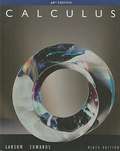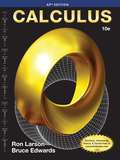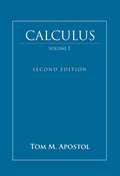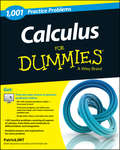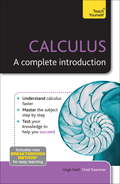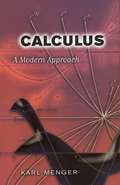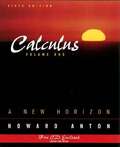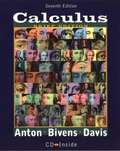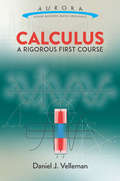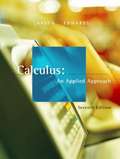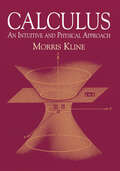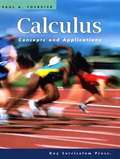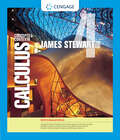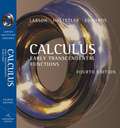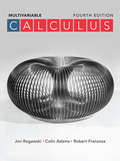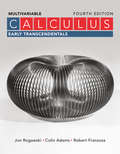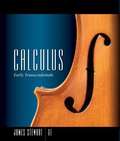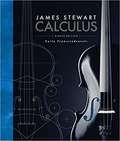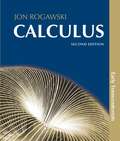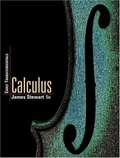- Table View
- List View
Calculus, AP Edition: Ap Edition
by William Briggs Lyle Cochran Bernard GillettNIMAC-sourced textbook
Calculus, Concepts and Calculators (Second Edition)
by Stephen Carter George Best Douglas CrabtreeThis book covers all the topics that are included in the new AP calculus course description,focusing on conceptual understanding and thinking skills.
Calculus, Volume 1
by Tom M. ApostolAn introduction to the Calculus, with an excellent balance between theory and technique. Integration is treated before differentiation--this is a departure from most modern texts, but it is historically correct, and it is the best way to establish the true connection between the integral and the derivative. Proofs of all the important theorems are given, generally preceded by geometric or intuitive discussion. This Second Edition introduces the mean-value theorems and their applications earlier in the text, incorporates a treatment of linear algebra, and contains many new and easier exercises. As in the first edition, an interesting historical introduction precedes each important new concept.
Calculus: 1,001 Practice Problems For Dummies (+ Free Online Practice)
by Patrick JonesPractice makes perfect--and helps deepen your understanding of calculus 1001 Calculus Practice Problems For Dummies takes you beyond the instruction and guidance offered in Calculus For Dummies, giving you 1001 opportunities to practice solving problems from the major topics in your calculus course. Plus, an online component provides you with a collection of calculus problems presented in multiple-choice format to further help you test your skills as you go. Gives you a chance to practice and reinforce the skills you learn in your calculus course Helps you refine your understanding of calculus Practice problems with answer explanations that detail every step of every problem The practice problems in 1001 Calculus Practice Problems For Dummies range in areas of difficulty and style, providing you with the practice help you need to score high at exam time.
Calculus: A Complete Introduction (Teach Yourself)
by Hugh NeillCalculus: A Complete Introduction is the most comprehensive yet easy-to-use introduction to using calculus. Written by a leading expert, this book will help you if you are studying for an important exam or essay, or if you simply want to improve your knowledge. The book covers all areas of calculus, including functions, gradients, rates of change, differentiation, exponential and logarithmic functions and integration. Everything you will need to know is here in one book. Each chapter includes not only an explanation of the knowledge and skills you need, but also worked examples and test questions.
Calculus: A Modern Approach
by Karl MengerOne of the twentieth century's most original mathematicians and thinkers, Karl Menger taught students of many backgrounds. In this, his radical revision of the traditional calculus text, he presents pure and applied calculus in a unified conceptual frame, offering a thorough understanding of theory as well as of the methodology underlying the use of calculus as a tool.The most outstanding feature of this text is the care with which it explains basic ideas, a feature that makes it equally suitable for beginners and experienced readers. The text begins with a "mini-calculus" which brings out the fundamental results without recourse to the notions of limit and continuity. The standard subject matter is then presented as a pure and unambiguous calculus of functions. The issues surrounding the applications of pure calculus to problems in the sciences are faced in a forthright manner by carefully analyzing the meaning of "variable quantity" and clarified by resuscitating Newton's concept of fluents. The accompanying exercises are original, insightful and an integral part of the text. This Dover edition features a new Preface and Guide to Further Reading by Bert Schweizer and Abe Sklar.
Calculus: A New Horizon
by Howard AntonThe new Sixth Edition of Anton's Calculus is a contemporary text that incorporates the best features of calculus reform, yet preserves the main structure of an established, traditional calculus text. This book is intended for those who want to move slowly into the reform movement. The new edition retains its accessible writing style and a high standard of mathematical precision.
Calculus: A New Horizon (Brief Edition)
by Howard AntonThe morning sun on the horizon is both a symbol of renewal and a reminder of the past- it signals the dawn of a new day, a new vitality, and new experiences, yet it reminds us that our predecessors have witnessed their own morning suns and that we are recipients of their innovations and experiences. So it is natural that we have chosen the morning sun for the cover of this text, since it holds the promise of a bold, fresh approach in this new edition that does not ignore the best qualities of the earlier editions. Howard Anton
Calculus: A Rigorous First Course
by Daniel J. VellemanDesigned for undergraduate mathematics majors, this rigorous and rewarding treatment covers the usual topics of first-year calculus: limits, derivatives, integrals, and infinite series. Author Daniel J. Velleman focuses on calculus as a tool for problem solving rather than the subject's theoretical foundations. Stressing a fundamental understanding of the concepts of calculus instead of memorized procedures, this volume teaches problem solving by reasoning, not just calculation. The goal of the text is an understanding of calculus that is deep enough to allow the student to not only find answers to problems, but also achieve certainty of the answers' correctness. No background in calculus is necessary. Prerequisites include proficiency in basic algebra and trigonometry, and a concise review of both areas provides sufficient background. Extensive problem material appears throughout the text and includes selected answers. Complete solutions are available to instructors.
Calculus: An Applied Approach
by Ron Larson Bruce H. Edwards David C. FalvoDesigned specifically for the non-math major who will be using calculus in business, economics, or life and social science courses, Calculus: An Applied Approach, 7/e, addresses students' weak math skills through added structure and guidance on how to study math. Special student-success-oriented sections include chapter-opening Strategies for Success; What You Should Learn--and Why You Should Learn It; Section Objectives; Chapter Summaries and Study Strategies; Try Its; Study Tips; and Warm-Up exercises. In addition the text presents Algebra Tips at point of use and Algebra Review at the end of each chapter. A strong support package includes the CL MATHSpace CD-ROM--which further emphasizes algebra review--and Instructional DVDs that allow students to review material outside of class.
Calculus: An Intuitive and Physical Approach (Second Edition) (Dover Books on Mathematics)
by Morris KlineApplication-oriented introduction relates the subject as closely as possible to science. In-depth explorations of the derivative, the differentiation and integration of the powers of x, and theorems on differentiation and antidifferentiation lead to a definition of the chain rule and examinations of trigonometric functions, logarithmic and exponential functions, techniques of integration, polar coordinates, much more. Clear-cut explanations, numerous drills, illustrative examples. 1967 edition. Solution guide available upon request.
Calculus: Concepts and Applications (2nd edition)
by Paul A. FoersterThe acclaimed Calculus: Concepts and Applications is now available in a new edition, revised to reflect important changes in the Advanced Placement curriculum, and updated to incorporate feedback from instructors throughout the U. S. With over 40 years of experience teaching AP Calculus, Paul Foerster developed Calculus: Concepts and Applications with the high school student in mind, but with all the content of a college-level course. Like the previous edition, the second edition follows the AP Calculus curriculum for both AB and BC levels. In Calculus: Concepts and Applications, students start off with calculus! Review of precalculus occurs at various points when itâ s needed. The text combines graphing-calculator technology with a unique, real-world application approach, and presents calculus as a study of just four fundamental concepts: limits, derivatives, definite integrals, and indefinite integrals. Students learn these concepts using algebraic, numerical, graphical, and verbal approaches. As a result, students with a wider range of abilities can be successful in calculus, not just those who are strong in algebra. The accompanying set of Explorations in the Instructorâ s Resource Book, designed for cooperative group work, gives students hands-on experience with new topics before they are formally introduced. In this new edition, derivatives of transcendental functions, related rates, as well as area and volume applications of the definite integral are introduced earlier. Additionally, the Instructorâ s Resource Book includes projects utilizing the CBLâ ¢, The Geometerâ s Sketchpad ®, and Fathom Dynamic Statisticsâ ¢ software, giving students extended opportunities to explore and understand calculus in depth
Calculus: Concepts and Contexts
by James StewartThis textbook develops the concepts behind functions, limits, derivatives and integrals, and introduces the solution of differential equations, the calculus of vector functions, and partial derivatives. The third edition updates data in the examples and adds projects on sprinkler water tanks, computer algebra systems, and 3D computer graphics. The CD-ROMs contain animations, activities, and eight hours of video instruction. Annotation ©2004 Book News, Inc. , Portland, OR (booknews. com)
Calculus: Concepts and Contexts
by James StewartOffering a more robust WebAssign course, Stewart's CALCULUS: CONCEPTS AND CONTEXTS, Enhanced Edition, 4th Edition, offers a streamlined approach to teaching calculus, focusing on major concepts and supporting those with precise definitions, patient explanations, and carefully graded problems. CALCULUS: CONCEPTS AND CONTEXTS is highly regarded because this text offers a balance of theory and conceptual work to satisfy more progressive programs as well as those who are more comfortable teaching in a more traditional fashion.
Calculus: Early Transcendental Functions
by Ron Larson Robert Hostetler Bruce H. EdwardsDesigned for the three-semester engineering calculus course, Calculus: Early Transcendental Functions, 4/e, continues to offer instructors and students innovative teaching and learning resources. Two primary objectives guided the authors in the revision of this book: to develop precise, readable materials for students that clearly define and demonstrate concepts and rules of calculus; and to design comprehensive teaching resources for instructors that employ proven pedagogical techniques and save time. The Larson/Hostetler/Edwards Calculus program offers a solution to address the needs of any calculus course and any level of calculus student. Every edition from the first to the fourth of Calculus: Early Transcendental Functions, 4/e has made the mastery of traditional calculus skills a priority, while embracing the best features of new technology and, when appropriate, calculus reform ideas. Now, the Fourth Edition is part of the first calculus program to offer algorithmic homework and testing created in Maple so that answers can be evaluated with complete mathematical accuracy.
Calculus: Early Transcendentals
by Jon Rogawski Colin Adams Robert FranzosaWe see teaching mathematics as a form of story-telling, both when we present in a classroom and when we write materials for exploration and learning. The goal is to explain to you in a captivating manner, at the right pace, and in as clear a way as possible, how mathematics works and what it can do for you. We find mathematics to be intriguing and immensely beautiful. We want you to feel that way, too.
Calculus: Early Transcendentals
by Jon Rogawski Colin Adams Robert FranzosaWe see teaching mathematics as a form of story-telling, both when we present in a classroom and when we write materials for exploration and learning. The goal is to explain to you in a captivating manner, at the right pace, and in as clear a way as possible, how mathematics works and what it can do for you. We find mathematics to be intriguing and immensely beautiful. We want you to feel that way, too.
Calculus: Early Transcendentals
by James StewartSuccess in your calculus course starts here! James Stewart's CALCULUS texts are world-wide best-sellers for a reason: they are clear, accurate, and filled with relevant, real-world examples. With CALCULUS: EARLY TRANCENDENTALS, Sixth Edition, Stewart conveys not only the utility of calculus to help you develop technical competence, but also gives you an appreciation for the intrinsic beauty of the subject. His patient examples and built-in learning aids will help you build your mathematical confidence and achieve your goals in the course!
Calculus: Early Transcendentals
by James StewartThe art of teaching, Mark Van Doren said, is the art of assisting discovery. I have tried to write a book that assists students in discovering calculus--both for its practical power and its surprising beauty. In this edition, as in the first seven editions, I aim to convey to the student a sense of the utility of calculus and develop technical competence, but I also strive to give some appreciation for the intrinsic beauty of the subject. Newton undoubtedly experienced a sense of triumph when he made his great discoveries. I want students to share some of that excitement.
Calculus: Early Transcendentals
by Jon RogawskiWhat's the ideal balance? How can you make sure students get both the computational skills they need and a deep understanding of the significance of what they are learning? With your teaching--supported by Rogawski's Calculus Second Edition--the most successful new calculus text in 25 years! Widely adopted in its first edition, Rogawski's Calculus worked for instructors and students by balancing formal precision with a guiding conceptual focus. Rogawski engages students while reinforcing the relevance of calculus to their lives and future studies. Precise mathematics, vivid examples, colorful graphics, intuitive explanations, and extraordinary problem sets all work together to help students grasp a deeper understanding of calculus. Now Rogawski's Calculus success continues in a meticulously updated new edition. Revised in response to user feedback and classroom experiences, the new edition provides an even smoother teaching and learning experience.
Calculus: Early Transcendentals (5th edition)
by James StewartCalculus: Early Transcendentals, Fifth Edition has the mathematical precision, accuracy, clarity of exposition and outstanding examples and problem sets that have characterized the first four editions. Stewart retains the focus on problem solving and the pedagogical system that has made the book a favorite of students and instructors in a wide variety of colleges and universities throughout the world. The structure of Calculus: Early Transcendentals, Fifth Edition, remains largely unchanged, the sole exception being that the review of inverse trigonometric functions has been moved from an appendix to Section 1. 6. Stewart has made hundreds of small improvements: new examples, additional steps in existing examples, updating of data in existing examples and exercises, new phrases and margin notes to clarify the exposition, references to other sources and web sites, redrawn art, and references to the TEC CD (Tools for Enriching Calculus). These refinements ensure that students and instructors using this text are using the best resource available. The number of pages in the book, however, remains unchanged from the 4th edition. This edition is complemented with and expanded array of supplementary material for both students and instructors. These best-selling texts differ from Calculus, Fifth Edition in that the exponential and logarithmic functions are covered earlier. In the Fifth Edition of Calculus: Early Transcendentals these functions are introduced in the first chapter and their limits and derivatives are found in Chapters 2 and 3 at the same time as polynomials and other elementary functions.
